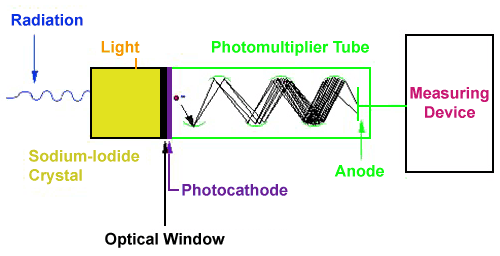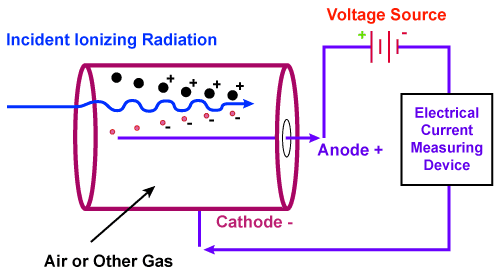Introduction to Radiation Detectors
Since we cannot see, smell or taste radiation, we are dependent on instruments to indicate the presence of ionizing radiation. Radiation is energy traveling in the form of particles or waves in bundles of energy called photons. Some everyday examples are microwaves used to cook food, radio waves for radio and television, light, and x-rays used in medicine.
Radioactivity is a natural and spontaneous process by which the unstable atoms of an element emit or radiate excess energy in the form of particles or waves. These emissions are collectively called ionizing radiations. Depending on how the nucleus loses this excess energy either a lower energy atom of the same form will result, or a completely different nucleus and atom can be formed.
Ionization is a particular characteristic of the radiation produced when radioactive elements decay. These radiations are of such high energy that when they interact with materials, they can remove electrons from the atoms in the material. This effect is the reason why ionizing radiation is hazardous to health, and provides the means by which radiation can be detected.
How Does a Radiation Detector Work?
SCINTILLATION DETECTOR: The basic principle behind this instrument is the use of a special material which glows or "scintillates" when radiation interacts with it. The most common type of material is a type of salt called sodium-iodide. The light produced from the scintillation process is reflected through a clear window where it interacts with device called a photomultiplier tube. The first part of the photomultiplier tube is made of another special material called a photocathode. The photocathode produces electrons when light strikes its surface. These electrons are then pulled towards a series of plates called dynodes through the application of a positive high voltage. When electrons from the photocathode hit the first dynode, several electrons are produced for each initial electron hitting its surface. This "bunch" of electrons is then pulled towards the next dynode, where more electron "multiplication" occurs. The sequence continues until the last dynode is reached, where the electron pulse is now millions of times larger then it was at the beginning of the tube.
At this point the electrons are collected by an anode at the end of the tube forming an electronic pulse. The pulse is then detected and displayed by the instrument.
GAS FILLED DETECTOR: This instrument works on the principle that as radiation passes through air or a specific gas, ionization of the molecules in the air occur. When a high voltage is placed between two areas of the gas filled space, the positive ions will be attracted to the negative side of the detector (the cathode) and the free electrons will travel to the positive side (the anode). These charges are collected by the anode and cathode which then form a very small current in the wires going to the detector. By placing a very sensitive current measuring device between the wires from the cathode and anode, the small current is measured and displayed as a signal. The more radiation which enters the chamber, the more current is displayed by the instrument. Many types of gas-filled detectors exist, but the two most common are the ion chamber used for measuring large amounts of radiation and the Geiger-Muller or GM detector used to measure very small amounts of radiation.
Scintillation Detector

Gas Filled Detector

